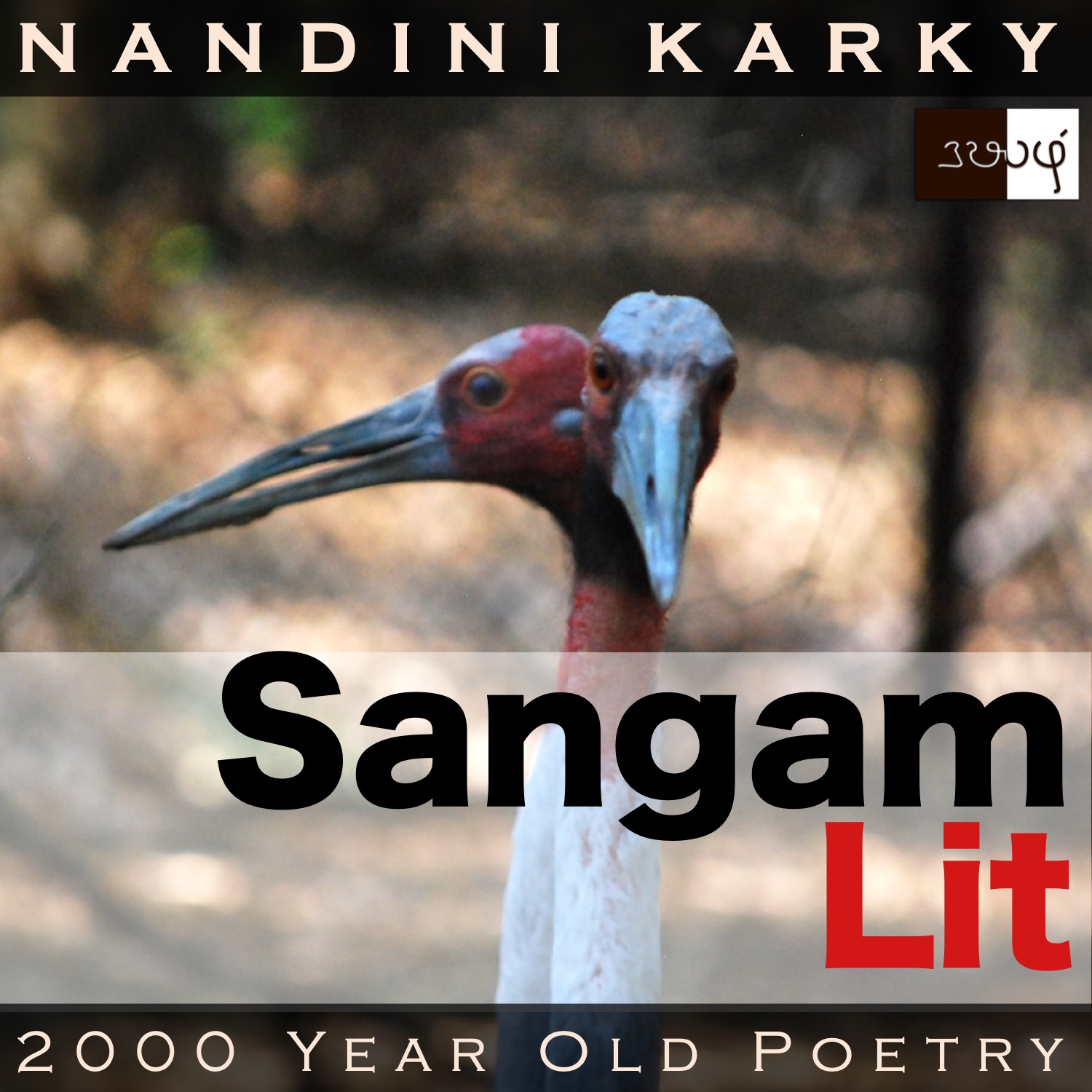Podcast: Play in new window | Download
Subscribe: Apple Podcasts | Spotify | Amazon Music | Android | iHeartRadio | TuneIn | RSS | More

In this episode, we relish references to a bird that lived in ancient India, as depicted in Sangam Literary work, Kurunthogai 160, penned by Madurai Maruthan Ilanaakanaar. Set in the mountains of ‘Kurinji’, the verse speaks in the voice of the lady to her confidante, in response to her friend’s consolation that the man would soon return.
நெருப்பின் அன்ன செந்தலை அன்றில்
இறவின் அன்ன கொடு வாய்ப் பெடையொடு,
தடவின் ஓங்கு சினைக் கட்சியில், பிரிந்தோர்
கையற நரலும் நள்ளென் யாமத்துப்
பெருந் தண் வாடையும் வாரார்;
இஃதோ-தோழி!-நம் காதலர் வரவே?
‘Torment of bird songs’ is the curious core of this one. Starting with the words ‘நெருப்பின் அன்ன செந்தலை’ meaning ‘a red head, akin to fire’, the verse mesmerises us with that vivid image. The owner of these bright hues turns out to be an ‘அன்றில்’ and we will explore shortly about which contemporary Indian bird this name refers to. After the head, there’s description of ‘a curved beak, akin to a shrimp’ in ‘இறவின் அன்ன கொடு வாய்’. Next, we see the habitat of the said bird in ‘தடவின் ஓங்கு சினைக் கட்சி’ meaning ‘nest on the high branches of the thada tree’. A hint of the time appears in ‘நள்ளென் யாமத்து’ meaning ‘the thick darkness of midnight’ and likewise, a clue about the season appears in ‘பெருந் தண் வாடை’ meaning ‘the cold, northern wind’ indicating the north-east monsoon season. Ending with the words ‘இஃதோ-தோழி!-நம் காதலர் வரவே’ meaning ‘Is this the lover seeking my hand, O friend’, the verse welcomes us to know more.
What do ‘andril’ birds and a dark, cold night have to say about the lady’s heart? The context reveals that the man and lady had been leading a love relationship when the man parted away to gather wealth for their wedding. Days roll by, and the lady’s anguish increases. Her confidante consoles her by saying that the man will indeed return soon to claim her hand. To these words, the lady says, “Having a fire-like red head, the ‘andril’, along with its female with a curved mouth, akin to a shrimp, sings from its nest on the high branch of a’ thada’ tree, making those separated feel helpless in the darkness of midnight. At this hour, when the cold and moist northern wind blows, he returns not. Is this, my friend, what you call his seeking my hand in marriage?” With these words, the lady rejects the consolation of her friend and expresses her anguish at being parted away from her love even in that difficult season.
Time to delve into the nuances. The lady starts by pointing to a male ‘Andril’ bird, describing it as having a head, streaked in fire-like red, and adding that its mate has a bent beak, which looks like a shrimp. She shows us their nest atop a high branch of a ‘thada’ tree. After these sights, now it’s time for sounds, for the lady starts talking about the song of these birds in the midnight hour, when the cold winds decide to swirl by. Explaining how this birdsong brings a deep misery to those separated, the lady turns to her friend and asks in frustration, ‘Is this how the man will marry me?’
When he is not here to allay the pain of my loneliness, how can you say he will care enough to come and seek my hand, the lady asks her confidante. Hopefully, the confidante has a stock of reassuring words to convince the lady that the man will indeed return soon. Leaving them both, let’s turn our attention to the ‘Andril’ bird mentioned. There has been some debate about whether the ‘Andril’ bird referenced in Sangam Literature is the ‘Sarus crane’, renowned for its long-term pair bonding, or the ‘Red-naped ibis’, as claimed by naturalist and photographer M. Krishnan. This particular verse gives us many details about the bird in question. Why don’t we use the same to try and zero in on the relevant bird? First, is the ‘fire-like red head’. These words are of no help because both the ‘Sarus crane’ and the ‘Red-naped ibis’ have red patches on their heads. The next clue is ‘a curved beak like a shrimp’ and we get warmer in our search because the ‘Sarus crane’ has more of a straight beak whereas the ‘Red-naped ibis’ indeed has a slightly curved beak. Moving on to the final description, this poem says that the ‘Andril’ bird sings from a nest on a high branch of a tree, and when we investigate the nesting behaviour of these two birds, the ‘Red-naped ibis’ always nests on trees, whereas the ‘Sarus crane’ always nests on the ground. And so, based on the description in this verse, the ‘Red-naped ibis’ is the more-suited candidate for the famous ‘Andril’ referred in numerous Sangam verses and celebrated for the deep bonding with their mates. Yet again, I end with gratitude to these ancient verses for teaching me so much about the world around me.




Share your thoughts...